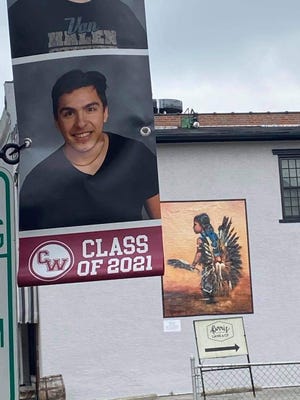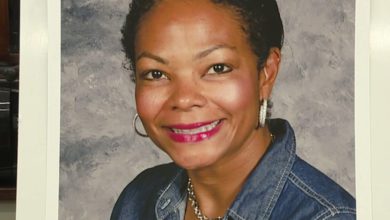

When Javier Vallejo's family moved schools, the Native American student was faced with a difficult decision: Wear Canal Winchester's Indians mascot on his baseball uniform or quit baseball.
Vallejo quit.
After Vallejo graduated this year, his mother Jessica Vallejo pulled her other two kids out of the school. The mother of six said the school district was unresponsive to her requests to provide a welcoming environment for her family.
"The psychological effects that have happened to my child are just a micro example of what is happening across the country to athletes who identify as Native," said Jessica Vallejo.

In light of the Cleveland Guardians name change, two Democratic representatives introduced a resolution encouraging Ohio's schools to retire Native American mascots. Jessica Vallejo, who consulted with the representatives on the resolution, wants an outright ban.
There are about 2,000 Native American or Alaska Native students in Ohio, equaling 0.1% of the state's students. Devon Shults, one of those students, said going to school in an environment missing their culture and traditions can be difficult for Native American students, and the mascots don't help.
"I'm going to school among my people's colonizers," said Shults, a citizen of the Muskogee Nation and a student at Oberlin High School.
Studies show Native American mascots have a negative impact on Native American students' self-esteem and present stereotypical images which undermine the educational experiences of all students.
"Native people understand how much tradition there is around sports. Native people invented one of the first team sports – it's stickball, the grandfather of lacrosse. So we get it," Shults said. "But sports is supposed to bring people together, not divide them."
While Black Lives Matter protests and racial reckoning prompted schools across Ohio to reconsider their Native American mascots, the National Congress of American Indians said few K-12 schools have changed their mascot since the summer of 2020.
Where we were a year ago: Ohio high schools re-evaluate Native American nicknames
Ohio has 195 schools with Native American mascots – the most of any state, according to the group's national database.
USA TODAY Network Ohio took a look at three schools across the state that have had a conversation about changing their Native American mascots.
Community pride: Bucyrus City Schools
In March, the Bucyrus City Schools Board of Education voted to keep its Redmen nickname and mascot after being approached by the National Congress of American Indians.

Read local reporting when it happened: Bucyrus school board votes to keep Redmen nickname
A public survey of more than 1,700 respondents found 79% of the community wanted to keep the mascot. Matt Chrispin, the Bucyrus City Schools superintendent, said the school mascot is a source of pride at Bucyrus and in similar small Ohio communities.
"I went to Salinas Senior High School and they were the Bulldogs. I suppose if PETA or somebody were trying to change it, I would feel a little weird about it," Chrispin said, adding he wasn't equating that with the "deeper concerns" about the Redmen name.

Chrispin said students were more open-minded about changing the mascot name than alumni, as students don't have the same sense of nostalgia alumni do and don't want to offend anyone.
"They kind of get it. And then they also go home and hear mom and dad who graduated from Bucyrus in 1970-whatever, and 'my god, don't change it, our class was the class that had the first mascot running around the field,'" Chrispin said.

Bucyrus City Schools started using Native American imagery in 1928. Sundance, the executive director of the Cleveland American Indian Movement who has a single name, said Native American mascots became popular in the 1930s as an extension of the American Indian Wars.
"I know for a fact that most people are not aware that they are encouraging a symbol of genocide," said Sundance, a citizen of the Muskogee Nation and Shults' father. "It should be said if there was a swastika in the bathroom, I wouldn't have to go through, you know, letter-writing campaigns and all these phone calls talking to administrators, etcetera."
Chrispin said the movement to change mascots across the country isn't going away, and he expects future efforts to change the mascot at Bucyrus.
Alumni lead the charge: Cuyahoga Heights
Madison Knaack was in her sophomore year when she felt something was wrong with her school's mascot, the Redskins. As a cheerleader, one of the cheers Knaack learned was "S-C-A-L-P, scalp them for a victory!"
"I was like, oh, OK, that's a little messed up," said Knaack, a 2018 Cuyahoga Heights graduate. "A lot of people would be like 'this isn't a big deal.' A kid would run around in a Native American headdress in red full-body paint."
Cynthia Connolly, a citizen of the Little Traverse Bay Bands of Odawa Indians, said these mascots open up opportunities for students to make "poor choices" like wearing headdresses or facepaint.
"We're more often than not portrayed as stuck in the historical past," said Connolly, who talked to Cuyahoga Heights administrators about changing the school's mascot. "It's what I called 'feathered and leathered in the 1800s.' We're rarely portrayed as your neighbors, your coworkers, or your classmates today."
The school has not used the cheer or a Native American head as a logo for several years, but resistance to changing the mascot was strong at Cuyahoga Heights.
At a June school board meeting on the mascot, the majority of public comments, both pro and con, were from alumni. Alumni listed honoring Native American ancestry, school pride and being against cancel culture as reasons to keep the mascot. One alumnus said her husband's dying wish was that his kids would be Redskins. Alumni against the mascot called it racist and offensive.
Dueling petitions, one to change the mascot with around 160 signatures and one to keep the mascot with 648 signatures, were promoted on personal pages of alumni and within alumni groups.
One student who asked for anonymity because she fears bullying said most students didn't want to change the mascot. She said students of color like herself are more likely to want to change the mascot because they "understand stereotypes and oppression on a deeper level."
"Cuyahoga Heights is a great school, but we don't need to keep the Native mascot to show how great we are," she said.
Earlier this month, the school board unanimously voted to retire the Redskins mascot. Superintendent Tom Evans told reporters the school will involve the community in choosing a new mascot. In the meantime, it will simply use "Heights."
Students first: Cincinnati Country Day School
When Bijin Basu went on Cincinnati Country Day School's 7th grade trip to a Cherokee reservation in North Carolina, he remembers being told not to wear or talk about the school's Indians mascot.
"The school knew that it was wrong," Basu, now a senior at the school, said.

A reservation field trip is more education than most U.S. schools offer on Native Americans. A 2019 report found 87% of state history standards do not include education on Native Americans past 1900.
"You cannot build an educational system about Native Americans around a mascot that includes stereotypes," said Kara Strass, the director of tribal relations at Miami University and a citizen of the Miami Tribe of Oklahoma.
Basu and other students often joked he was "two types of Indian" as a lighthearted way to point out the problems with the mascot.
Now, Basu is on the school's Equity, Diversity and Inclusion Committee, part of the school's efforts to create a more inclusive community. As a committee member, Basu explained at a school panel last summer why the mascot conflicted with his Indian identity. In January, the school changed its mascot.
Basu said students were essential to the change, and students of color were the first to point out what was wrong with the mascot.
"I would say by being a POC, it's like, the forefront of your identity is 'how can I maintain my culture, how can I maintain my traditions,'" Basu said. "A big part of that is being respected by others and making sure nothing is being appropriated but appreciated."
The school's mascot committee fielded 200 unique community submissions and allowed students, alumni and faculty to vote on the new mascot. They overwhelmingly chose the Nighthawks.

Aaron Kellenberger, the director of enrollment at Country Day School, and his 10-year-old son, Nathan, were both on the mascot committee. Kellenberger said it was often new students or faculty moving into Ohio who questioned the mascot, leading the school to believe the mascot wasn't inclusive. Ohio has no federally recognized tribes, which advocates say helps Ohio ignore the history of the state's Indigenous peoples.
Nathan said schools thinking about changing their mascot should listen to students first.
"Their students need to be proud of what they're wearing and what they're putting forward," Nathan said. "They shouldn't have students that hate what they have to wear."
Grace Deng is a reporter for the USA TODAY Network Ohio Bureau, which serves the Columbus Dispatch, Cincinnati Enquirer, Akron Beacon Journal and 18 other affiliated news organizations across Ohio.
Source link







